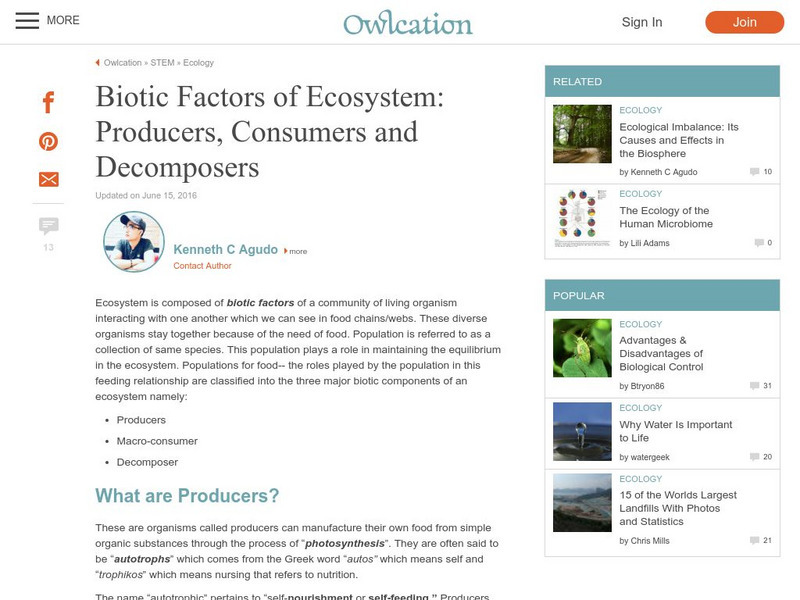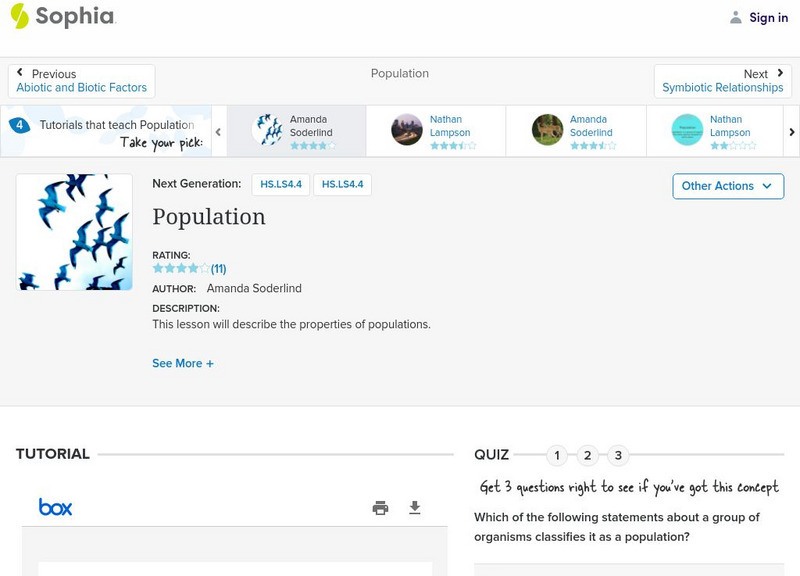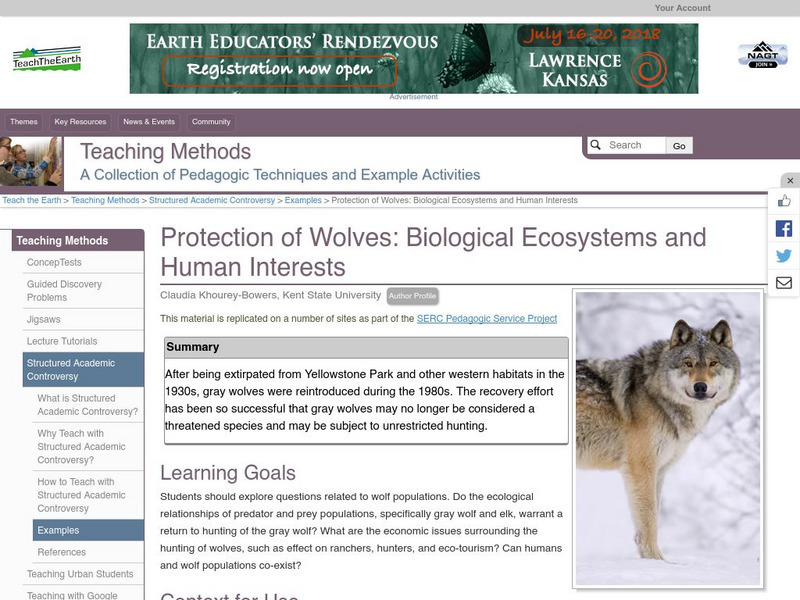Utah STEM Foundation
Utah Stem Action Center: Great Salt Lake Ecosystem
This lesson plan provides an eight-day flow of educational activities in which students use the Great Salt Lake ecosystem to explore food webs and how changes in living and nonliving factors affect different populations.
CK-12 Foundation
Ck 12: Life Science: 12.5 Population Growth Limits
Discover how ecosystems respond to population growth limits.
CK-12 Foundation
Ck 12: Life Science: 12.4 Population Growth Patterns
Explore growth patterns in wildlife populations.
Other
Pde Sas: Relationships Among Organisms
In this lesson, students compare various types of relationships among organisms (i.e., biotic interactions). Students will: explain the roles of producers and consumers, and predators and prey in an ecosystem. Explain the levels of order...
PBS
Pbs Learning Media: A Subsistence Culture Impacted by Climate Change
This short video explains how warmer temperatures in the Arctic are transforming the ecosystem and affecting the Athabaskan people, threatening their way of life. [2:59]
Other
Hub Pages: Biotic Factors of Ecosystem: Producers, Consumers and Decomposers
An ecosystem is composed of biotic factors of a community of living organisms interacting with one another which we can see in food chains/webs. These diverse organisms stay together because of the need of food. Population is referred to...
Sophia Learning
Sophia: Population: Lesson 2
This lesson will describe the properties of populations. It is 2 of 8 in the series titled "Population."
Sophia Learning
Sophia: Population: Lesson 3
This lesson will describe the properties of populations. It is 3 of 8 in the series titled "Population."
Sophia Learning
Sophia: Population: Lesson 4
This lesson will describe the properties of populations. It is 4 of 8 in the series titled "Population."
Polk Brothers Foundation Center for Urban Education at DePaul University
De Paul University: Center for Urban Education: Changing the Ecosystem: Q & a [Pdf]
"Changing the Ecosystem: Q & A" is a one page, nonfiction, reading passage about how the loss of the prairie to farming and population growth impacts the ecosystem. It is followed by questions which require students to provide...
Climate Literacy
Clean: Climate Change and Arctic Ecosystems
Students learn about how climate change is affecting the Arctic ecosystem, and then investigate how this change is impacting polar bear populations. Students analyze maps of Arctic sea ice, temperature graphs, and polar bear population...
Texas Instruments
Texas Instruments: Jason: Island Fox: A Population in Trouble
Examine the relationship between the island fox and golden eagle populations on Santa Cruz Island over a twelve-year period using the TI-73 Explorer to graph and analyze the values.
Oswego City School District
Regents Prep: Ecosystems/communities
Abiotic factors vary in the environment and determining the types and numbers of organisms that exist in that environment. Factors which determine the types and numbers of organisms of a species in an ecosystem are called limiting...
Science Education Resource Center at Carleton College
Serc: Protection of Wolves: Biological Ecosystems and Human Interests
Young scholars will exam the different perspectives on why the gray wolf was reintroduced into many western states during the 1980s, the success of the reintroduction, and the benefits and problems from the recovery of the gray wolf...
Science Education Resource Center at Carleton College
Serc: Eagles in the Ecosystem Classroom Jigsaw Activity
In this in-depth jigsaw activity, students investigate the role bald eagles play in the ecosystem, why they were listed as endangered, the effects of DDT on eagles, and the effects of lead on eagles. Furthermore, students will then graph...
Scholastic
Scholastic: Endangered Ecosystems: Costa Rican Caterpillars
Go on a mission to Costa Rica and Mexico, and explore the state of tropical rain forest ecosystems by examining Costa Rican caterpillars. Learn what the change in this animal's population means for the rest of the ecosystem.
ClassFlow
Class Flow: Understanding Ecosystems: Part 1 of 4
[Free Registration/Login Required] Students will get an introduction to ecosystems. They will be able to distinguish nonliving and living thins in a habitat.
TeachEngineering
Teach Engineering: Computer Simulation of the Sonoran Desert Community
The computer program's simulation of a Sonoran desert community should ultimately strengthen the student's comprehension of what is required for a natural ecosystem to sustain itself (remain in balance). This computer simulation program...
National Geographic
National Geographic: Symbiotic Relationships in Marine Ecosystems
In this lesson students analyze videos to make observations about species, populations, and communities of organisms and discuss their symbiotic relationships. Then they create a hypothetical marine ecosystem and describe the adaptive,...
National Geographic
National Geographic: Oil and Bird Populations
After learning about the diversity of wildlife in the Gulf of Mexico, students focus on birds and their patterns of behavior. They then how an oil spill might affect migrating birds, and possible ways to help them in the event of an oil...
Science Struck
Science Struck: The 6 Chief Levels of Organization in Ecology
Describes six levels of organization in the biological world - individual species, population, community, ecosystem, biome, and biosphere.
Alabama Learning Exchange
Alex: Endangered Species
This is a biology or environmental science lesson that incorporates technology. This project-based plan is designed to be used as students study the factors that affect the dynamic equilibrium of populations and ecosystems. This lesson...
American Institute of Biological Sciences
Action Bioscience: The Decline of North American Freshwater Fishes
An article addressing the need of immediate action to repair damages of declining life in the ecosystems of North American inland bodies of water.
CK-12 Foundation
Ck 12: Earth Science: Biological Communities Study Guide
Review the relationship between populations and ecosystems.



















